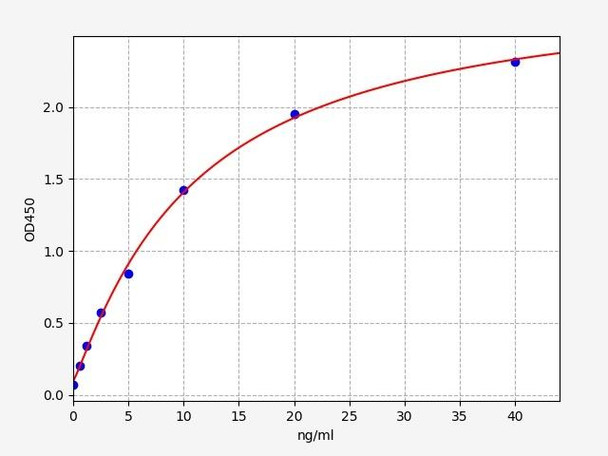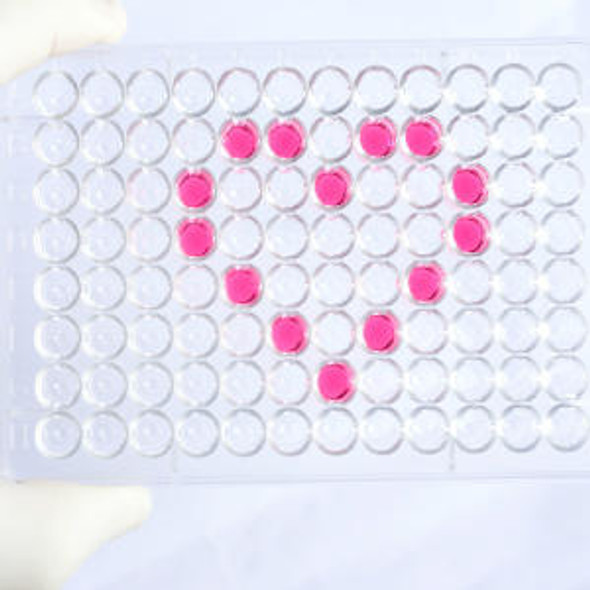Human IGF2R / M6P ELISA Kit
- SKU:
- HUFI02576
- Product Type:
- ELISA Kit
- Size:
- 96 Assays
- Uniprot:
- P11717
- Sensitivity:
- 0.375ng/ml
- Range:
- 0.625-40ng/ml
- ELISA Type:
- Sandwich
- Synonyms:
- IGF2R, CD222, CIMPR, M6P-R, MPR1, MPRI, cation-independent mannose-6-phosphate receptor, Cation-independent mannose-6-phosphate receptor, CI Man-6-P receptor, CI-MPR, M6PR, M6P, IGF2 receptor, M6P, IGF2R, Insulin-like growth factor II receptor, IGF-I
- Reactivity:
- Human
- Research Area:
- Signal Transduction
Description
Human IGF2R / M6P ELISA
IGF2R / M6P encodes a receptor for both insulin-like growth factor 2 and mannose 6-phosphate. IGF2R / M6P has various functions, including intracellular trafficking of lysosomal enzymes and activation of transforming growth factor beta. Mutation or loss of heterozygosity of IGF2R / M6P has been associated with an increased risk of hepatocellular carcinoma. The Assay Genie Human IGF2R / M6P ELISA is a highly sensitive assay for the quantitative measurement of IGF2R / M6P in serum, blood, plasma, cell culture supernatant and tissue samples.
| Product Name: | Human IGF2R / M6P ELISA Kit |
| Product Code: | HUFI02576 |
| Size: | 96 Assays |
| Alias: | IGF2R, CD222, CIMPR, M6P-R, MPR1, MPRI, cation-independent mannose-6-phosphate receptor, Cation-independent mannose-6-phosphate receptor, CI Man-6-P receptor, CI-MPR, M6PR, M6P, IGF2 receptor, M6P, IGF2R, Insulin-like growth factor II receptor, IGF-II receptor, 300 kDa mannose 6-phosphate receptor, MPR 300, Insulin-like growth factor 2 receptor |
| Detection method: | Sandwich ELISA, Double Antibody |
| Application: | This immunoassay kit allows for the in vitro quantitative determination of Human IGF2R concentrations in serum plasma and other biological fluids. |
| Sensitivity: | 0.375ng/ml |
| Range: | 0.625-40ng/ml |
| Storage: | 4°C for 6 months |
| Note: | For Research Use Only |
| Recovery: | Matrices listed below were spiked with certain level of Human IGF2R and the recovery rates were calculated by comparing the measured value to the expected amount of Human IGF2R in samples. | ||||||||||||||||
| |||||||||||||||||
| Linearity: | The linearity of the kit was assayed by testing samples spiked with appropriate concentration of Human IGF2R and their serial dilutions. The results were demonstrated by the percentage of calculated concentration to the expected. | ||||||||||||||||
| |||||||||||||||||
| CV(%): | Intra-Assay: CV<8% Inter-Assay: CV<10% |
| Component | Quantity | Storage |
| ELISA Microplate (Dismountable) | 8×12 strips | 4°C for 6 months |
| Lyophilized Standard | 2 | 4°C/-20°C |
| Sample/Standard Dilution Buffer | 20ml | 4°C |
| Biotin-labeled Antibody(Concentrated) | 120ul | 4°C (Protect from light) |
| Antibody Dilution Buffer | 10ml | 4°C |
| HRP-Streptavidin Conjugate(SABC) | 120ul | 4°C (Protect from light) |
| SABC Dilution Buffer | 10ml | 4°C |
| TMB Substrate | 10ml | 4°C (Protect from light) |
| Stop Solution | 10ml | 4°C |
| Wash Buffer(25X) | 30ml | 4°C |
| Plate Sealer | 5 | - |
Other materials and equipment required:
- Microplate reader with 450 nm wavelength filter
- Multichannel Pipette, Pipette, microcentrifuge tubes and disposable pipette tips
- Incubator
- Deionized or distilled water
- Absorbent paper
- Buffer resevoir
| Uniprot | P11717 |
| UniProt Protein Function: | IGF2R: a multifunctional type I transmembrane protein receptor that binds insulin-like growth factor 2 at the cell surface and mannose-6-phosphate-tagged proteins in the trans-Golgi network. Also known as the cation-independent mannose-6 phosphate (M6P) receptor. Clears IGF2 from the cell surface to attenuate signaling, and transports M6P-tagged lysosomal enzymes from the Golgi complex and the cell surface to lysosomes. M6P-tagged lysosomal enzymes bind specifically to mannose-6- phosphate receptors in the Golgi apparatus and the resulting receptor-ligand complex is transported to an acidic prelyosomal compartment where the low pH mediates the dissociation of the complex. Acts as a positive regulator of T-cell coactivation, by binding DPP4. Belongs to the MRL1/IGF2R family. |
| UniProt Protein Details: | Protein type:Membrane protein, integral; Receptor, misc.; Vesicle Chromosomal Location of Human Ortholog: 6q26 Cellular Component: cell surface; clathrin coat; early endosome; endocytic vesicle; endosome; extracellular space; focal adhesion; integral to plasma membrane; late endosome; lysosomal membrane; membrane; nuclear envelope lumen; perinuclear region of cytoplasm; trans-Golgi network; trans-Golgi network transport vesicle Molecular Function:enzyme binding; G-protein alpha-subunit binding; G-protein coupled receptor activity; glycoprotein binding; identical protein binding; insulin-like growth factor II binding; insulin-like growth factor receptor activity; mannose binding; phosphoprotein binding; protein binding; receptor activity; retinoic acid binding; transporter activity Biological Process: G-protein coupled receptor protein signaling pathway; insulin-like growth factor receptor signaling pathway; liver development; organ regeneration; positive regulation of apoptosis; post-embryonic development; receptor-mediated endocytosis; response to retinoic acid; signal transduction; spermatogenesis Disease: Hepatocellular Carcinoma |
| NCBI Summary: | This gene encodes a receptor for both insulin-like growth factor 2 and mannose 6-phosphate. The binding sites for each ligand are located on different segments of the protein. This receptor has various functions, including in the intracellular trafficking of lysosomal enzymes, the activation of transforming growth factor beta, and the degradation of insulin-like growth factor 2. Mutation or loss of heterozygosity of this gene has been association with risk of hepatocellular carcinoma. The orthologous mouse gene is imprinted and shows exclusive expression from the maternal allele; however, imprinting of the human gene may be polymorphic, as only a minority of individuals showed biased expression from the maternal allele (PMID:8267611). [provided by RefSeq, Nov 2015] |
| UniProt Code: | P11717 |
| NCBI GenInfo Identifier: | 317373416 |
| NCBI Gene ID: | 3482 |
| NCBI Accession: | P11717.3 |
| UniProt Secondary Accession: | P11717,Q7Z7G9, Q96PT5, |
| UniProt Related Accession: | P11717 |
| Molecular Weight: | 274,375 Da |
| NCBI Full Name: | Cation-independent mannose-6-phosphate receptor |
| NCBI Synonym Full Names: | insulin like growth factor 2 receptor |
| NCBI Official Symbol: | IGF2R |
| NCBI Official Synonym Symbols: | MPR1; MPRI; CD222; CIMPR; M6P-R; MPR300; CI-M6PR; MPR 300; M6P/IGF2R |
| NCBI Protein Information: | cation-independent mannose-6-phosphate receptor |
| UniProt Protein Name: | Cation-independent mannose-6-phosphate receptor |
| UniProt Synonym Protein Names: | 300 kDa mannose 6-phosphate receptor; MPR 300; Insulin-like growth factor 2 receptor; Insulin-like growth factor II receptor; IGF-II receptor; M6P/IGF2 receptor; M6P/IGF2R; CD_antigen: CD222 |
| Protein Family: | Cation-independent mannose-6-phosphate receptor |
| UniProt Gene Name: | IGF2R |
| UniProt Entry Name: | MPRI_HUMAN |
*Note: Protocols are specific to each batch/lot. For the correct instructions please follow the protocol included in your kit.
Before adding to wells, equilibrate the SABC working solution and TMB substrate for at least 30 min at 37°C. When diluting samples and reagents, they must be mixed completely and evenly. It is recommended to plot a standard curve for each test.
| Step | Protocol |
| 1. | Set standard, test sample and control (zero) wells on the pre-coated plate respectively, and then, record their positions. It is recommended to measure each standard and sample in duplicate. Wash plate 2 times before adding standard, sample and control (zero) wells! |
| 2. | Aliquot 0.1ml standard solutions into the standard wells. |
| 3. | Add 0.1 ml of Sample / Standard dilution buffer into the control (zero) well. |
| 4. | Add 0.1 ml of properly diluted sample ( Human serum, plasma, tissue homogenates and other biological fluids.) into test sample wells. |
| 5. | Seal the plate with a cover and incubate at 37 °C for 90 min. |
| 6. | Remove the cover and discard the plate content, clap the plate on the absorbent filter papers or other absorbent material. Do NOT let the wells completely dry at any time. Wash plate X2. |
| 7. | Add 0.1 ml of Biotin- detection antibody working solution into the above wells (standard, test sample & zero wells). Add the solution at the bottom of each well without touching the side wall. |
| 8. | Seal the plate with a cover and incubate at 37°C for 60 min. |
| 9. | Remove the cover, and wash plate 3 times with Wash buffer. Let wash buffer rest in wells for 1 min between each wash. |
| 10. | Add 0.1 ml of SABC working solution into each well, cover the plate and incubate at 37°C for 30 min. |
| 11. | Remove the cover and wash plate 5 times with Wash buffer, and each time let the wash buffer stay in the wells for 1-2 min. |
| 12. | Add 90 µl of TMB substrate into each well, cover the plate and incubate at 37°C in dark within 10-20 min. (Note: This incubation time is for reference use only, the optimal time should be determined by end user.) And the shades of blue can be seen in the first 3-4 wells (with most concentrated standard solutions), the other wells show no obvious color. |
| 13. | Add 50 µl of Stop solution into each well and mix thoroughly. The color changes into yellow immediately. |
| 14. | Read the O.D. absorbance at 450 nm in a microplate reader immediately after adding the stop solution. |
When carrying out an ELISA assay it is important to prepare your samples in order to achieve the best possible results. Below we have a list of procedures for the preparation of samples for different sample types.
| Sample Type | Protocol |
| Serum | If using serum separator tubes, allow samples to clot for 30 minutes at room temperature. Centrifuge for 10 minutes at 1,000x g. Collect the serum fraction and assay promptly or aliquot and store the samples at -80°C. Avoid multiple freeze-thaw cycles. If serum separator tubes are not being used, allow samples to clot overnight at 2-8°C. Centrifuge for 10 minutes at 1,000x g. Remove serum and assay promptly or aliquot and store the samples at -80°C. Avoid multiple freeze-thaw cycles. |
| Plasma | Collect plasma using EDTA or heparin as an anticoagulant. Centrifuge samples at 4°C for 15 mins at 1000 × g within 30 mins of collection. Collect the plasma fraction and assay promptly or aliquot and store the samples at -80°C. Avoid multiple freeze-thaw cycles. Note: Over haemolysed samples are not suitable for use with this kit. |
| Urine & Cerebrospinal Fluid | Collect the urine (mid-stream) in a sterile container, centrifuge for 20 mins at 2000-3000 rpm. Remove supernatant and assay immediately. If any precipitation is detected, repeat the centrifugation step. A similar protocol can be used for cerebrospinal fluid. |
| Cell culture supernatant | Collect the cell culture media by pipette, followed by centrifugation at 4°C for 20 mins at 1500 rpm. Collect the clear supernatant and assay immediately. |
| Cell lysates | Solubilize cells in lysis buffer and allow to sit on ice for 30 minutes. Centrifuge tubes at 14,000 x g for 5 minutes to remove insoluble material. Aliquot the supernatant into a new tube and discard the remaining whole cell extract. Quantify total protein concentration using a total protein assay. Assay immediately or aliquot and store at ≤ -20 °C. |
| Tissue homogenates | The preparation of tissue homogenates will vary depending upon tissue type. Rinse tissue with 1X PBS to remove excess blood & homogenize in 20ml of 1X PBS (including protease inhibitors) and store overnight at ≤ -20°C. Two freeze-thaw cycles are required to break the cell membranes. To further disrupt the cell membranes you can sonicate the samples. Centrifuge homogenates for 5 mins at 5000xg. Remove the supernatant and assay immediately or aliquot and store at -20°C or -80°C. |
| Tissue lysates | Rinse tissue with PBS, cut into 1-2 mm pieces, and homogenize with a tissue homogenizer in PBS. Add an equal volume of RIPA buffer containing protease inhibitors and lyse tissues at room temperature for 30 minutes with gentle agitation. Centrifuge to remove debris. Quantify total protein concentration using a total protein assay. Assay immediately or aliquot and store at ≤ -20 °C. |
| Breast Milk | Collect milk samples and centrifuge at 10,000 x g for 60 min at 4°C. Aliquot the supernatant and assay. For long term use, store samples at -80°C. Minimize freeze/thaw cycles. |
Fill out our quote form below and a dedicated member of staff will get back to you within one working day!






